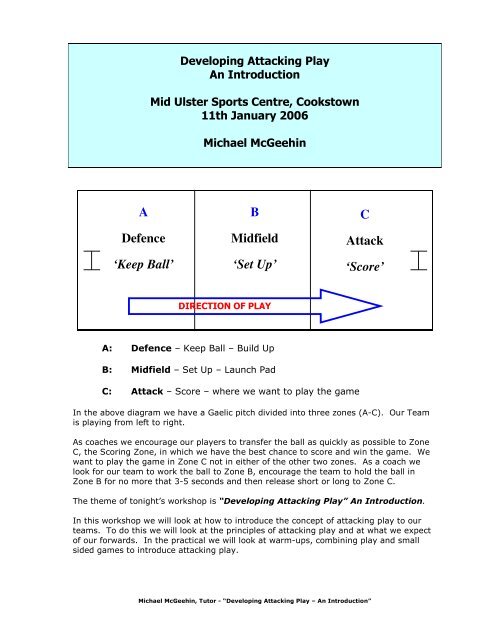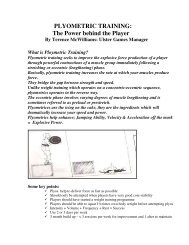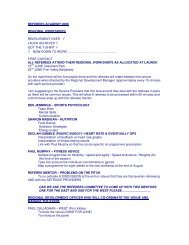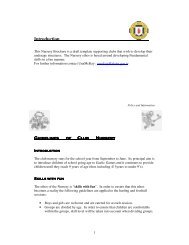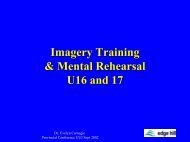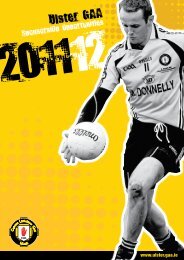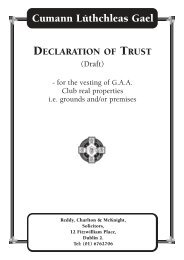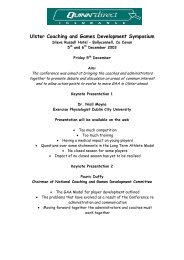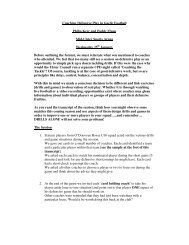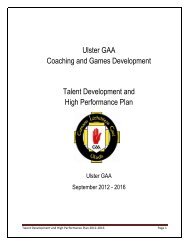Developing Attacking Play - Ulster GAA
Developing Attacking Play - Ulster GAA
Developing Attacking Play - Ulster GAA
You also want an ePaper? Increase the reach of your titles
YUMPU automatically turns print PDFs into web optimized ePapers that Google loves.
A<br />
Defence<br />
‘Keep Ball’<br />
<strong>Developing</strong> <strong>Attacking</strong> <strong>Play</strong><br />
An Introduction<br />
Mid <strong>Ulster</strong> Sports Centre, Cookstown<br />
11th January 2006<br />
Michael McGeehin<br />
A: Defence – Keep Ball – Build Up<br />
B: Midfield – Set Up – Launch Pad<br />
C: Attack – Score – where we want to play the game<br />
In the above diagram we have a Gaelic pitch divided into three zones (A-C). Our Team<br />
is playing from left to right.<br />
As coaches we encourage our players to transfer the ball as quickly as possible to Zone<br />
C, the Scoring Zone, in which we have the best chance to score and win the game. We<br />
want to play the game in Zone C not in either of the other two zones. As a coach we<br />
look for our team to work the ball to Zone B, encourage the team to hold the ball in<br />
Zone B for no more that 3-5 seconds and then release short or long to Zone C.<br />
The theme of tonight’s workshop is “<strong>Developing</strong> <strong>Attacking</strong> <strong>Play</strong>” An Introduction.<br />
B<br />
Midfield<br />
‘Set Up’<br />
DIRECTION OF PLAY<br />
In this workshop we will look at how to introduce the concept of attacking play to our<br />
teams. To do this we will look at the principles of attacking play and at what we expect<br />
of our forwards. In the practical we will look at warm-ups, combining play and small<br />
sided games to introduce attacking play.<br />
Michael McGeehin, Tutor - “<strong>Developing</strong> <strong>Attacking</strong> <strong>Play</strong> – An Introduction”<br />
C<br />
Attack<br />
‘Score’
To look at how we develop this we must first look at, know and understand the<br />
Principles of <strong>Attacking</strong> <strong>Play</strong>.<br />
These include:<br />
DEPTH: � Support on the ball<br />
� <strong>Play</strong>ers as Targets<br />
� Short and long ball passing options<br />
PENETRATION:<br />
WIDTH:<br />
MOBILITY:<br />
IMPROVISATION:<br />
COMMUNICATION:<br />
Figure 1—Adapted from Wade (1972)<br />
Penetration<br />
Width<br />
Mobility<br />
Improvisation<br />
ATTACK<br />
� Moving the ball through or into the oppositions defence at<br />
speed<br />
� <strong>Play</strong>ing balls into wide positions to draw and isolate<br />
defenders away from each other and from central positions<br />
giving more space inside for forwards to use<br />
� The movement of players in from or behind the ball<br />
therefore moving defensive players out of position and<br />
causing disruption in their defence.<br />
� <strong>Play</strong>ers making runs to leave space for others<br />
� <strong>Play</strong>ers changing roles/positions or doing the unusual<br />
� Supporting <strong>Play</strong>ers giving verbal and non verbal signals to<br />
the <strong>Play</strong>ers in possession.<br />
PRINCIPLES OF ATTACK & DEFENCE<br />
MIDFIELD<br />
BALL POSSESSION<br />
DEPTH<br />
COMMUNICATION<br />
DEFENCE<br />
Delay<br />
Concentration<br />
Balance<br />
Control/Restraint<br />
Michael McGeehin, Tutor - “<strong>Developing</strong> <strong>Attacking</strong> <strong>Play</strong> – An Introduction”
PRINCIPLES OF ATTACK &DEFENCE Cont.<br />
Forwards – Objectives<br />
� To score<br />
� To create scores for team mates<br />
� To create space and expose<br />
defenders<br />
� To retain possession and get into<br />
scoring positions as quickly as<br />
possible<br />
Effective Use of Space in the Forward Line<br />
1 =<br />
MOST useful space<br />
for decoy runs.<br />
LEAST useful space<br />
for receiving the ball<br />
1. - WARM UP GAMES: SOLO TAG<br />
1<br />
1<br />
� To make runs off the ball (sacrifice)<br />
and take defenders out of position<br />
� To defend, make it difficult for<br />
defenders to clear the ball<br />
� To win possession<br />
� Mobility – keep on the move when<br />
not in possession and attempt to pull<br />
defenders out of position<br />
� Organisation – Grid 20 x 20m, 1 tagger and enough footballs<br />
for one ball between two<br />
1. Game of Tag with a difference – only players not in<br />
possession of the ball can be tagged. <strong>Play</strong>ers in possession<br />
of the ball can’t be tagged.<br />
2. Tagger attempts to tag player without the ball. If<br />
successful tagged player changes places with him.<br />
3. Normal rules of soloing.<br />
4. Encourage players in possession to pass to player<br />
who is being chased by the tagger.<br />
Michael McGeehin, Tutor - “<strong>Developing</strong> <strong>Attacking</strong> <strong>Play</strong> – An Introduction”<br />
2<br />
1<br />
1<br />
45m<br />
2 =<br />
MOST useful space for<br />
receiving the ball<br />
LEAST useful space<br />
for decoy runs<br />
20m<br />
In this game;<br />
Mobility<br />
Support<br />
Penetration<br />
Communication<br />
Width<br />
20
2. - WARM UP GAMES: 4 + 4 v 4<br />
3. - WARM UP GAMES: Long Ball<br />
45m<br />
End Line<br />
A A<br />
Direction<br />
of Team<br />
‘A’ <strong>Play</strong><br />
B<br />
���� Organisation: Grid 20 x 20m with 4 cones/poles placed 5m out<br />
from the grid at each side. 2 sets of bibs, 1 team of 4 in blue bibs<br />
and 1 team of 4 in red bibs (together play as attackers). I team<br />
without bibs act as defenders.<br />
1. Attackers attempt to keep possession – They get a score for<br />
every 10 successful passes.<br />
2. After every pass the passer must sprint<br />
out of the grid and to around the nearest<br />
cone/pole and comes back into the game<br />
to support the man on the ball.<br />
3. Defenders attempt to win and retain<br />
possession of the ball.<br />
4. Change roles after 2-4 minutes.<br />
Direction<br />
of Team<br />
‘B’ <strong>Play</strong><br />
B<br />
45m<br />
� Organisation: – Grid Endline to 45m line,<br />
footballs , cones/poles and bibs<br />
1. Two Teams organised with bibs.<br />
2. Each Team to defend the Grids.<br />
3. Team A & B places a player into each of<br />
the grids they are attacking.<br />
4. Object of the Games is to play the ball to<br />
the player in the Grid they are attempting<br />
to score in. Defending Team cannot<br />
enter the grid.<br />
5. Once the <strong>Play</strong>er in Grid collects the ball<br />
cleanly this counts as a score. The<br />
receiving player immediately plays the ball<br />
to a team mate. The <strong>Play</strong>er who gave this<br />
pass into the grid changes places with the<br />
receiver.<br />
� Variation:<br />
1. Take the <strong>Play</strong>ers out of the Grids. To score the ball has to be worked to a<br />
team mate who gets into the grid to receive the pass – <strong>Play</strong>ers can only<br />
stay in the Grid for three seconds.<br />
Michael McGeehin, Tutor - “<strong>Developing</strong> <strong>Attacking</strong> <strong>Play</strong> – An Introduction”<br />
In this game;<br />
Mobility<br />
Support<br />
Penetration<br />
Communication<br />
Improvisation
3<br />
xxx<br />
1. – COMBINATION PLAYS:<br />
2. - COMBINATION PLAYS:<br />
In this play;<br />
Width<br />
Accurate Passing<br />
Movement after pass<br />
Penetration<br />
Support<br />
Communication<br />
� Organisation = Grid 40/45m x 40/45m,<br />
<strong>Play</strong>ers divided between markers A,B,C,D.<br />
Footballs<br />
1. Long ball from A to B<br />
2. B collects and plays the ball back to A<br />
3. B sprints around cone<br />
4. A plays diagonal ball to C, who collects<br />
5. C plays ball to B and runs around cone<br />
6. B plays diagonal ball to D<br />
7. Drill continues.<br />
� Variation: Add I extra ball and/or Change<br />
Direction<br />
3. - COMBINATION PLAYS:<br />
XXX<br />
XXX<br />
2<br />
A<br />
B C<br />
xxx<br />
1<br />
A<br />
3<br />
X<br />
X<br />
4<br />
D<br />
xxx<br />
xxx<br />
X<br />
X<br />
X<br />
D<br />
B X<br />
C<br />
XXX<br />
� Organisation = Grid 40/45m x 40/45m,<br />
<strong>Play</strong>ers divided between markers A,B,C,D etc.<br />
Footballs<br />
1. First <strong>Play</strong>er at A passes to first<br />
player at B and continues to run.<br />
2. B collects and plays the ball back<br />
to A<br />
3. B sprints around cone and receives<br />
pass from A who joins back of<br />
Group B<br />
4. B passes long to C who collects<br />
and returns ball back to B<br />
5. Drill continues.<br />
� Variation: Add I extra ball and/or change<br />
direction<br />
� Organisation = Grid 40/45m x 40/45m,<br />
6 <strong>Play</strong>ers at A, 3 players at each of B, C, D.<br />
Footballs<br />
1. Ball among first three players at A long<br />
pass from them to Group at B. A follow<br />
the ball to B.<br />
2. Group B collects, pass to each other once<br />
on the move and play ball to Group C. B<br />
continues to C<br />
3. Drill continues.<br />
� Variation: Add I extra ball<br />
and/or change direction<br />
Michael McGeehin, Tutor - “<strong>Developing</strong> <strong>Attacking</strong> <strong>Play</strong> – An Introduction”<br />
xxx<br />
3<br />
2<br />
A<br />
B<br />
xxx<br />
1<br />
6<br />
In this play;<br />
Communication<br />
Support<br />
Mobility<br />
In this play;<br />
Accurate Passing<br />
Quick Movement<br />
after pass<br />
Communication<br />
Support<br />
4<br />
D<br />
C<br />
xxx<br />
5<br />
xxx
4. - COMBINATION PLAYS:<br />
� Organisation = Grid – half pitch<br />
Footballs (unlimited) and cones. First ball<br />
is to the right corner Group C<br />
1. A passes ball to B and keeps moving<br />
forward<br />
2. B collects and plays the ball back to A<br />
and B turns and runs to C<br />
3. A passes a long ball to C and joins<br />
back of Group B<br />
4. C collects and passes ball long to D. C<br />
continues to back of Group D<br />
5. D collects and solo’s back to Group A<br />
6. Second ball is to the left corner –<br />
Group E<br />
7. Third ball is to cone C etc<br />
8. Drill continues.<br />
� Variation:<br />
1. As above only this time B sprints towards C,<br />
receives the ball from C and plays the ball back to<br />
C in front of him. C passes to D<br />
2. New group (G) go behind goals. C plays the ball<br />
to D who runs toward the goals. D receives ball,<br />
takes 4 paces, no solo and strikes ball over the<br />
bar. D goes to G. G collects and solos out to A.<br />
� First Ball: A-B-C-D-G-A<br />
� Second Ball: A-B-E-F-G-A<br />
5. - COMBINATION PLAYS:<br />
� Organisation = Half Pitch, Footballs &<br />
Cones<br />
1. Footballs at A – <strong>Play</strong>ers at A, B, C, D<br />
and E.<br />
2. A plays back to B (follows direction of<br />
ball) B collects ball<br />
3. C makes diagonal run across in front of<br />
B. B passes ball to C. C continues<br />
diagonal run.<br />
4. D makes run wide and<br />
receives ball from C. D<br />
takes 4 paces and shoots<br />
for a point.<br />
5. E collects and brings ball<br />
to A. (A-B-C-D-E-A)<br />
6. Drill continues.<br />
In this play;<br />
Mobility<br />
Width<br />
Depth<br />
Penetration<br />
Communication<br />
� Variation: Same drill finishing from the<br />
right wing. And/or add defenders.<br />
F xxx<br />
Michael McGeehin, Tutor - “<strong>Developing</strong> <strong>Attacking</strong> <strong>Play</strong> – An Introduction”<br />
4<br />
D<br />
xxx<br />
xxx<br />
E<br />
6<br />
1<br />
O<br />
O<br />
O<br />
B<br />
xxx<br />
5<br />
xxx<br />
X<br />
X<br />
X<br />
2<br />
A<br />
In this play;<br />
3<br />
Mobility<br />
Communication<br />
Width<br />
Depth<br />
Penetration<br />
Combination <strong>Play</strong>s<br />
2<br />
E<br />
xxx<br />
A<br />
oooo<br />
oooo<br />
B<br />
1<br />
X<br />
X<br />
X<br />
3<br />
D<br />
xxx<br />
C<br />
xxx<br />
C<br />
4<br />
45m<br />
45m
In this play;<br />
Mobility<br />
Penetration<br />
Communication<br />
1. - SMALL SIDED GAMES:<br />
� Organisation = 1 x Portable Goals, 1 x fixed<br />
goals, ¼ pitch (30m x 30m). Bibs, Footballs &<br />
Cones<br />
1. 4v3 – Goal Keepers in goals. 4v3 on the<br />
pitch. Team of 4 attacks the large goals and<br />
Team of 3 attack the portable goals.<br />
2. Next Team of 4 players ready behind the<br />
portable goals.<br />
3. Next Team of 3 ready behind the large goals<br />
� Variation :<br />
1. Two minutes on for both teams. Keep<br />
scores, normal rules.<br />
2. Conditioned Game – 1 designated<br />
forward on Team of 4 to stay in full<br />
forward position.<br />
3. Conditioned Game – 4v4 – The Team in<br />
possession have 1 minute to score a goal. If they<br />
score they leave the pitch immediately and the<br />
Defenders stay on, retrieve the ball and attempt to<br />
score before next attacking team comes on to the<br />
pitch.<br />
2- SMALL SIDED GAMES:<br />
� Organisation = 1 x Portable Goals, 1 x fixed<br />
goals, ¼ pitch (30m x 30m). Bibs, Footballs &<br />
Cones<br />
1. Divide players into two teams A & B with bibs.<br />
� Team A & B then further divides. Half of<br />
Team A goes to Cone A, the other half to<br />
Cone B on the diagonal.<br />
� Half of Team B goes to Cone C and the<br />
other half to Cone D on the diagonal.<br />
2. <strong>Play</strong>ers at each cone number themselves 1, 2,<br />
3, etc. Goalkeeper in both goals. On the pitch<br />
excluding the goalkeepers you will have 2v2<br />
at any one time.<br />
3. Coach is positioned centrally with footballs.<br />
4. Coach throws the ball into the pitch in any<br />
direction for the number 1’s in each group to<br />
contest (2v2). They have 1 minute to score a<br />
goal. If a goal is scored inside a minute both<br />
teams go off and the coach plays in the next<br />
ball for the number 2’s, etc.<br />
5. If no goal is scored the coach call both teams<br />
off and plays next ball.<br />
30m<br />
30m<br />
Michael McGeehin, Tutor - “<strong>Developing</strong> <strong>Attacking</strong> <strong>Play</strong> – An Introduction”<br />
x x x<br />
x<br />
4v3<br />
x x x x<br />
In this play;<br />
Mobility<br />
Penetration<br />
Communication<br />
Depth<br />
Width<br />
A C<br />
D<br />
x<br />
x<br />
x<br />
x<br />
x<br />
x<br />
x<br />
x<br />
x<br />
x<br />
x<br />
x<br />
x<br />
x<br />
x<br />
x<br />
x<br />
x<br />
Coach<br />
oooooo<br />
B<br />
30m<br />
30m
45m<br />
3. - SMALL SIDED GAMES: - CONTINUOUS BACKS -V- FORWARDS<br />
x<br />
x A x A<br />
x A<br />
x A<br />
Coach<br />
oooooo<br />
x A<br />
In this play;<br />
Combination <strong>Play</strong><br />
Mobility<br />
Depth<br />
Width<br />
Communication<br />
Penetration<br />
x A<br />
45m<br />
� Organisation = Area (½ Pitch). Bibs,<br />
Footballs & Cones/Poles<br />
1. 3 Games set up beyond the 45m line<br />
� 6 Backs –v- 6 Forwards<br />
2. Coach plays ball to one of the Forwards<br />
� If forwards score a point they get the<br />
next ball. If forwards score a goal they<br />
get the next two balls.<br />
3. If Defenders win the ball they must work<br />
the ball out through one of the three gates.<br />
Once they do this the game does not stop,<br />
the Defenders immediately become<br />
Forwards and attempt to score. (The<br />
Attackers revert to defend)<br />
� Variation<br />
1. Goalkeeper to take a kick out, whichever<br />
Team wins the ball can attack immediately.<br />
2. Add in a Midfielder as an extra player for<br />
the Team in possession.<br />
This workshop is an introduction to attacking play. If you want to ask me<br />
any questions on any aspects of the workshop you can contact me on<br />
mkmcg@eircom.net or michael.mcgeehin@lyit.ie<br />
Michael McGeehin, Tutor - “<strong>Developing</strong> <strong>Attacking</strong> <strong>Play</strong> – An Introduction”


